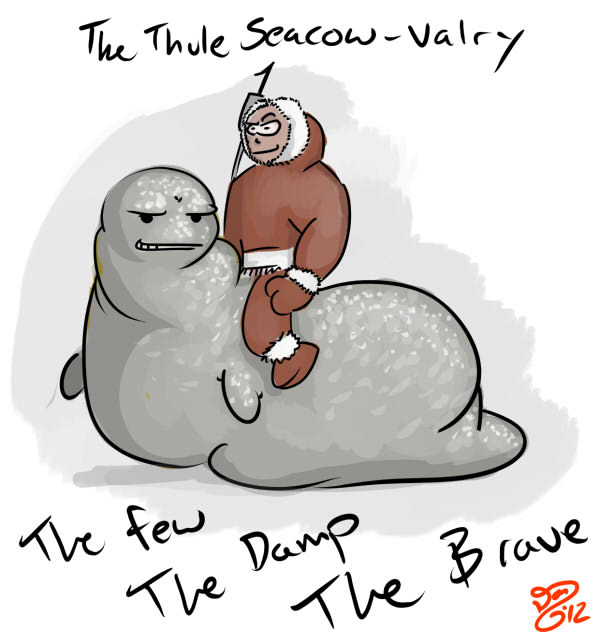Hey, what are the chances that southern people adopting caribou (or moose!) riding? Unlike agriculture, animal-riding might be a relatively easy habit to pick up (as a comparison, it took the comanches about 140 years to adopt horses:
http://www.comanchelanguage.org/Comanche Timeline.htm).
Given the historical range of caribou...
(
http://www.gophoto.it/view.php?i=ht...images/map-caribou-rangeloss.png#.UHW_J66Ge0Y)
Even assuming people don't artificially extend the range of these animals, English settlers at Popham should expect to find the natives with reindeer "cavalries" (rangiferies?).
There will probably also be an effect here with the more rapid spread of disease post-contact.
Well, there's the matter of size. Consider horses:
Light riding horses usually range in height from 14 to 16 hands (56 to 64 inches, 142 to 163 cm) and can
weigh from 380 to 550 kilograms (840 to 1,200 lb).
[24] Larger riding horses usually start at about 15.2 hands (62 inches, 157 cm) and often are as tall as 17 hands (68 inches, 173 cm),
weighing from 500 to 600 kilograms (1,100 to 1,300 lb).
[25] Heavy or
draft horses are usually at least 16 hands (64 inches, 163 cm) high and can be as tall as 18 hands (72 inches, 183 cm) high. They
can weigh from about 700 to 1,000 kilograms (1,500 to 2,200 lb).
The rule seems to be that for an effective riding animal, at least as far as horses go, the mount should be around 15% of the animal's weight. At the size ranges we have here for horses, that suggests riders between 140 and 330 lbs - basically the human range.
Generally, the more weight an animal carries as a pack or a rider, the more work it has to do, the slower it goes or the faster it tires. If you have a pony that can be ridden, but only for short distances, then you'll end up walking most of the time.
Apply this rule to Caribou, and:
The
females usually measure 162–205 cm (64–81 in) in length and
weigh 80–120 kg (180–260 lb)
[15] The
males (or "bulls") are typically larger (although the extent to which varies in the different subspecies), measuring 180–214 cm (71–84 in) in length and
usually weighing 159–182 kg (350–400 lb),[15] though exceptionally large males have weighed as much as 318 kg (700 lb).[15] Shoulder height typically measure from 85 to 150 cm (33 to 59 in), and the tail is 14 to 20 cm (5.5 to 7.9 in) long.
From our friend, Wikipedia. Lets assume that the Thule are small people, weighing between 110 and 150 lbs.
Now, apply that 15% rule, and you'll get riders for females of an average weight of 27 lbs to 39 lbs. Males would support riders of 52 to 60 lbs, and really exceptionally large males could maybe take a rider of 105. That doesn't seem very viable, does it.
But Caribou seem to have a much greater load bearing capacity than horses. Caribou for packs seem to beat everything but dogs. So let's assume a load bearing ability 50% or more greater than horses. 22.5%. Hell let's round it up to 25%.
At that rate, it starts to become almost viable. Female carriers would still be too small - 45 to 65 lbs. Males would be almost there - 85 to 100 lbs. Exeptionally large males would maybe be able to carry 175, though.
So, how does this all work. It seems to me that exceptionally large animals in nature are just that - exceptional. Say one in ten, or one in twenty. They're the big ass end of the bell curve.
So under normal circumstances, I'd expect the domesticated population to be no larger than the wild population. Generally in fact, the rule is that domesticates in most cases are smaller than the wild forms. But let's go with that equivalency.
This means that in the normal course, opportunities to find a caribou big enough to ride safely and comfortably are going to be relatively rare. One animal in ten or twenty, and when you factor in all the scruff factors, maybe one in forty or one in fifty.
That really makes it hard for any population which is accessing wild strains, or strains indistinguishable from wild, to have a decent cavalry.
So maybe the Thule grow them bigger? Entirely possible. We grew our horses bigger. There's a trade off, of course. Bigger animals eat more, which counts in the thin environment of the north. There's no particular advantage to big animals for carrying packs. Its just a matter of more and fewer animals and how you spread the weight.
There might be a cumulative advantage to bigger animals for dragging plows. So there might be some incentive to 'breed bigger' in the agricultural areas, particularly the longest settled and established agricultural areas. You might get animals going 600 lbs or more regularly, say instead of one in twenty, one in five or one in three.
If riding starts to develop as a regular or somewhat common thing, rather than as an unusual or freakish activity, then that's the population that will most likely be ridden, and subject to further selective breeding for riding.
In outlying areas, among herdsmen, riding may be reserved to a headman, or a couple of high ranking men. In the densely populated areas, there will be enough large animals to sustain a regular mounted force or cavalry, and both the incentive and breeding stock wealth to 'breed big.'
For these reasons, I don't think Caribou riding will make it south. The sorts of Caribou that southern peoples will encounter will tend to be too small.
Again, give it another five hundred or eight hundred years, until Bred-Big stock is so common it can end up in the hands of southern peoples. But we don't have that kind of time. History is about to happen to us.

